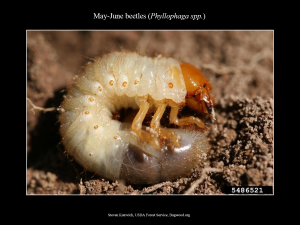White Grub
go.ncsu.edu/readext?898289
en Español / em Português
El inglés es el idioma de control de esta página. En la medida en que haya algún conflicto entre la traducción al inglés y la traducción, el inglés prevalece.
Al hacer clic en el enlace de traducción se activa un servicio de traducción gratuito para convertir la página al español. Al igual que con cualquier traducción por Internet, la conversión no es sensible al contexto y puede que no traduzca el texto en su significado original. NC State Extension no garantiza la exactitud del texto traducido. Por favor, tenga en cuenta que algunas aplicaciones y/o servicios pueden no funcionar como se espera cuando se traducen.
Português
Inglês é o idioma de controle desta página. Na medida que haja algum conflito entre o texto original em Inglês e a tradução, o Inglês prevalece.
Ao clicar no link de tradução, um serviço gratuito de tradução será ativado para converter a página para o Português. Como em qualquer tradução pela internet, a conversão não é sensivel ao contexto e pode não ocorrer a tradução para o significado orginal. O serviço de Extensão da Carolina do Norte (NC State Extension) não garante a exatidão do texto traduzido. Por favor, observe que algumas funções ou serviços podem não funcionar como esperado após a tradução.
English
English is the controlling language of this page. To the extent there is any conflict between the English text and the translation, English controls.
Clicking on the translation link activates a free translation service to convert the page to Spanish. As with any Internet translation, the conversion is not context-sensitive and may not translate the text to its original meaning. NC State Extension does not guarantee the accuracy of the translated text. Please note that some applications and/or services may not function as expected when translated.
Collapse ▲Two kinds of white grubs occur in corn fields; annual white grubs (chafer larvae) and true white grubs (May or June beetle larvae). Both types eat corn roots but the true white grubs are potentially more damaging. These larvae are typical “C” shaped white beetle grubs. Annual white grubs have scattered hairs on the posterior (raster) whereas true white grubs have two parallel rows of hairs on the posterior.
Both types of white grubs eat corn roots, preferring the root hairs and small rootlets. Injured plants seldom die but may be stunted and express signs of nutrient or moisture deficiency (due to the compromised root system). This would only occur when grub populations are high and are primarily true white grub species. White grubs prefer to lay eggs in grasses and the larvae overwinter in the soil. Therefore, high populations are usually limited to corn following pasture or other grassy circumstances. Tillage may also destroy many white grubs prior to planting and high populations are more common in conservation tillage situations, especially strip-tillage or no-tillage.
White grubs seldom justify a structured management approach or the use of a soil insecticide. However, in situations where white grubs are most likely, other soil dwelling insects may also be a threat. In this case the complex of seedling and root feeding insects may justify specific management practices including the use of a seed treatment or a soil insecticide. These situations would be most likely when tillage and rotation are restricted and if grassy circumstances precede the current corn crop.






